
Ring-talked lemur: the national animal symbol of Madagascar. Photo by: Rhett A. Butler.
In the fight for conservation Madagascar is without a doubt on the front lines. Not only are most of its forests already destroyed—with a mere 10% of intact forest remaining at best—but there’s still much to lose in what remains.
Madagascar is listed as having the third highest primate diversity in the world, with all primate species being lemurs. Lemurs are basal primates, representing rare traits similar to those of ancestral primates; they are a rare glimpse into the genetic past of primates. As such, they’re even a glimpse into the deep past of distant human ancestors. Lemurs are only found in Madagascar and on nearby islands and, according to scientists, 90 percent of all lemur species face extinction within the next 20 to 25 years.
To say Madagascar is like no place else on earth is an understatement. There are impressive levels of biodiversity and endemism in almost every form of life on the world’s fourth largest island. Scientists estimate that eighty-five percent of the flowering plant species found on Madagascar are endemic. The island holds three times the species of palms found on the entire continent of Africa, most of these found nowhere else on earth. There are forests of Baobab trees consisting of six species in Madagascar, while Africa contains only two species, and Australia one species.
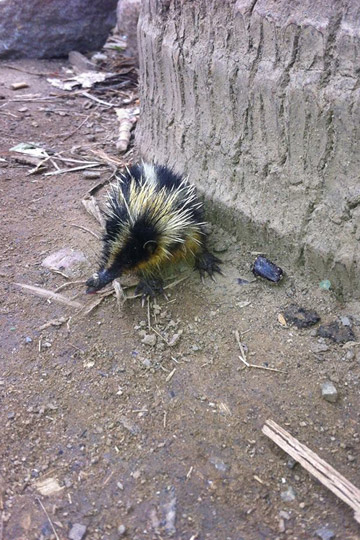 A lowland streaked Tenrec at the village of Ambalohosy Sud where the team collected compost for reforestation. Photo by: Zach Fitzner. |
Over 90 percent of Madagascar’s reptile species are endemic. There are approximately 150 species of chameleons worldwide and Madagascar holds 59 species of them found nowhere else—and that’s just chameleons. The geckoes of Madagascar are as fascinating. The leaf tailed geckos, in the genus Urolplatus, are masters of camouflage; the fish scaled gecko can shed its scales instantly to escape, running from predators pink and naked. There’s also the mystery of the Malagasy boa, a snake found not in Asia, not in main land Africa, but only on Madagascar and the much further new world tropics; no one knows why.
Given the unique biology in mammals, plants, and reptiles alone (not even considering the wealth of invertebrates, birds and amphibians found in Madagascar) it is not surprising that many biologists and conservationists take special interest in the island nation.
I spent a full five months in Madagascar. Most of my visit was spent volunteering for a reforestation project in Kianjavato, Madagascar not more than two hours slow drive from the World Heritage site of Ranomofauna National Park. While I was there, I met volunteers, local graduate students, foreign biologists, and local peasants—all of whom were working with the lemurs. Everyone was passionate about this island, its secrets, and its future. Even with common interests not everyone had the same ideas about what’s best for Madagascar.
Superstition and taboos known as fady abound and poverty is omnipresent in Madagascar. One gets the impression of a nation full of young people trying desperately to balance their own national identity with a foreign, global culture that they simultaneously run to assimilate into but only half understand.
Fadys and superstitions vary wildly from place to place throughout Madagascar, sometimes helping and sometimes hindering conservation efforts. In one region, the Aye Aye is considered a harbinger of evil and killed indiscriminately; in another region the nocturnal lemur is considered an embodiment of revered ancestors. Undisturbed nature is both revered and sometimes considered a hindrance to progress by the Malagasy.

Viktor, a local Malagasy, and Tessa, an American volunteer, during a reforestation planting. Bamboo stakes mark seedlings. Photo by: Zach Fitzner.
The influence of missionaries, foreign aid and western biologists is also very visible. Churches of many denominations are common in all the villages and cities I visited. Gideon Bibles seem as much a part of the local hotels as in the U.S.; the only difference being they are appropriately written in Malagasy. Schools teach lessons in French and more and more commonly in English. However, most Malagasy people, especially in rural areas, are not fluent in either French or English. Research stations, modern infrastructure (such as bridges), and hotels built by foreign nations are also commonplace. For a nation trying desperately to find its place; a country whose government recently participated in tentative democratic elections, there are armies of competing interests, many of them foreign.
In some areas the most intact forests are those surrounding tombs: made either from natural caves or laboriously constructed stone mausoleums, the tombs and trees surrounding them are considered sacred. In other areas local tourism companies offer multi-day excursions into national parks with guides, porters, cooks and lemongrass tea served daily. Poor infrastructure is omnipresent, causing a stumbling block for what could be a thriving tourism industry.
Rice paddies march tediously up the hills surrounding many villages, painstakingly cut by hand. Many days I was sweating in the sun, and working hard replanting rainforest. Yet only a short distance from our reforestation efforts, one could see men, shirtless and shoeless, in the mud whipping zebus (a local breed of cattle) to laboriously plow their rice fields. Agriculture is carried out primarily as a subsistence activity in the more rural areas of Madagascar, the surplus sent for sale to the larger cities. Jack fruit, litchi, banana and mango are in abundance and the trees often seem as if part of the forest to the untrained eye. Sugar cane and cassava grow in small fields near houses. Everywhere, through forest and field there is a network of footpaths walked by everyone in the community, making private property seem all but non-existent. Fires to clear land for agriculture or ‘tavy’ are common. Rare is a week that passes in Kianjavato, where I worked in east central Madagascar, when one does not see smoke rising from a would-be rice paddy.
On a short two kilometer walk along a small river near Kianjavato one can see hundreds of people panning for gold in the shade of hills where scientists closely monitor endangered lemurs, which are sometimes killed illegally by locals. Radio collars cut by knife and found inexpertly hidden under loose rocks, taken from the necks of desperately rare lemurs emphasize the conflict between people and wildlife here. Less obvious is the implied conflict between local and western values, reflected by that same radio collar.
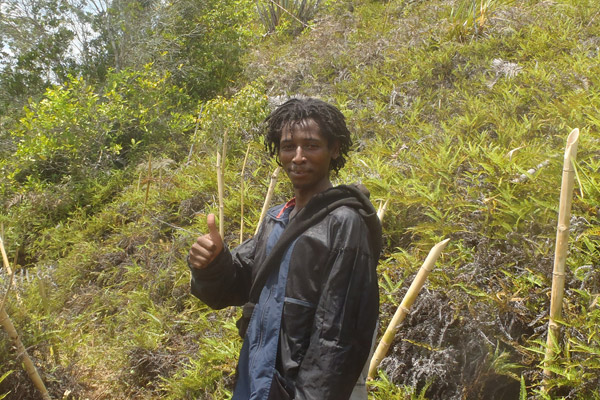
Herry a local Malagasy man gives a thumbs up at a reforestation planting where he came to generously pass out water and snacks to the people planting seedlings.
As a westerner with the massive potential of the ecotourism trade in mind one might ask if those who kill lemurs and so quickly burn the forest think about their children’s future. As a lemur-volunteer once said to me, they think about how to feed them (their children) right now. In the Kianjavato commune, farming, clearing land and maybe even killing lemurs puts more food into mouths than tourist dollars.
The organization I volunteered for employs a large percentage of the local population but considering that the daily laborers we hire are paid 5,000 Ar a day (the local currency), and local (luke-warm) beer costs 2,500 Ar or a liter of bottled water is 2,000 Ar one has to wonder how much of a favor we’re doing them. Still there are preciously few opportunities to make money in the area and people from 12 year-old boys to women nearing 70 line up asking for work. It’s never hard hiring the sometimes more than 200 laborers for a week of reforestation work; what’s harder is telling scores of other people that we’ve hired all we need and have no additional work.
The work isn’t easy either, nor does the money put into the community stop at hiring labor. Compost is purchased from local midden heaps and men are hired to dig it out and carry it away in 50 lb nylon sacks that once held concrete. More men are hired to carry baskets full of seedlings across rice paddies and up hills; and women to plant those seedlings usually un-sheltered in the hot tropical sun. The seedlings planted are each marked by a bamboo pole ordered and sourced locally from bamboo stands.
However much money is put into the local community and however well intentioned, one must ask how different this work really is from colonialism? This is after-all work being planned and carried out mostly by a foreign organization employing foreign volunteers and a few highly-educated Malagasy from more urban areas. These outsiders supervise locals who have done this work for years and are experts in their own right. Foreigners collect the data and ultimately it is Americans, and a few well off Malagasy, that reap the harvest of data from the labor of rural Malagasy in the form of published research and acknowledgement. The work is also back breaking, sometimes spending hours working with only a shovel for the approximate equivalent of $2.50 U.S. dollars a day.
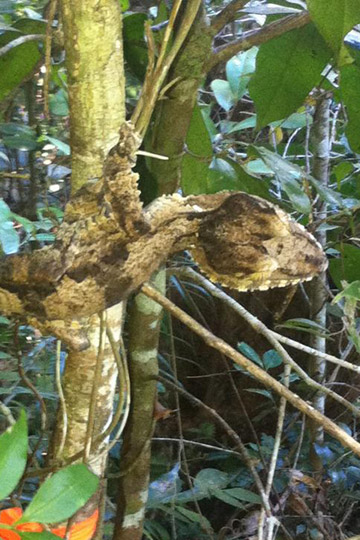 A leaf-tailed gecko encountered while tagging along with a team researching the black and white ruffed lemur. Photo by: Zach Fitzner. |
Not only is the work hard and the compensation incommensurate, but it’s difficult to gauge the success of the project. The majority of the trees planted in the reforestation effort are non-native. Some of these trees are planted as pioneer species; fast growing nitrogen fixing trees intended to create an environment healthier for more finicky native forest trees. Other trees are fruit, coffee, cocoa, and other edibles planted near human populations areas for local consumption.
One can easily see the logic and benevolence in planting these trees. However, the question remains: what do we know of the long term effect of planting hundreds of thousands of fast growing pioneer species? In Madagascar little is known, one of the most commonly planted trees here, a species of Acacia was found to be invasive in Brazil. The tree itself is native to Australia and has been used for commercial forestry the world over and also for reforestation efforts such as in Madagascar. The idea is that it can improve soil quality and create shade for slower growing natives. With Acacia’s fast life cycle it will hopefully be easy to remove once the native trees have taken hold. But this is not what’s happened in Brazil, instead the tree is out of control, spreading far beyond its original planting and nearly impossible to stop. Despite being tropical, Brazil is still a poor model for Madagascar. With its unique assemblage of life and isolation, Madagascar is not only a rare treasure trove but also especially vulnerable to negative impact from non-native plants and animals. There is also little work being done here to look at survival rate of the plantings in Kianjavato. Not much is known about how the reforestation efforts here impact the local environment or community over the long term.
With these concerns in mind, I decided to do some research of the issues at hand. I was mostly concerned with the effects of planting large mixed groups of trees dominated by the hardy, fast growing non-native Acacia mangium. I was also curious if other organizations planted this or any other non-native trees in their reforestation efforts.
Martin Gardner, a conifer expert from the Royal Botanic Gardens of Edinburgh, had this to say: “As soon as one chooses to use non-native plant species for forestry then a whole array of problems are going to follow which will have a long-term negative effect on the environment.”
Still, the question remained, is it necessary to plant trees like Acacia? Is the soil so bad that the only recourse is making the best of things and planting a non-native to improve soil? I contacted Victoria Gutierrez of ‘WeForest’ that runs reforestation efforts in Madagascar as well as all over the world.
“The decision of planting exotic species is mainly driven by their perceived economic advantage. However, if reforestation is designed with the purpose of increasing tree cover and local biodiversity, there is no reason to plant exotics. Moreover, biodiversity conservation is a very good strategy to reduce food poverty. Even in very damaged soils (e.g. in Burkina Faso) we are able to succeed with native trees.”
Besides limited amounts of trees planted near villages for fruit and other products, her organization doesn’t plant any non-native trees. In Madagascar specifically, she told me only native trees are planted.
Keeping this in mind, one might begin to wonder, when non-native trees are planted in Madagascar by a foreign organization, are we helping? Are we conserving biodiversity and creating ecotourism jobs, or are we pushing foreign values and foreign species on a place so different, that we cannot possibly expect what works elsewhere to continue to work there? Anyone pursuing conservation work in a place like Madagascar should ask themselves, if their goal is to help whether their methods fit with a place like no other on earth or if they’re really trying to change the place to suit their own desires.
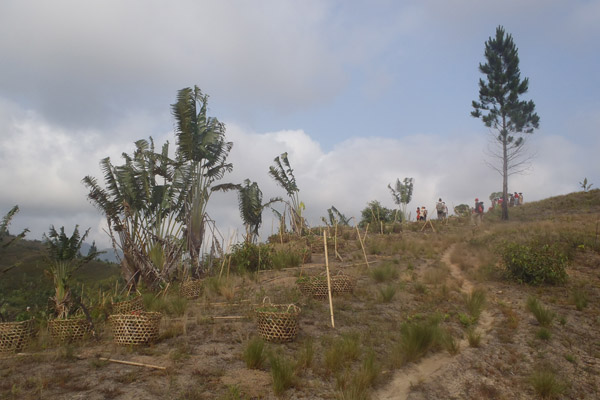
A reforestation site just as people are arriving to plant. Photo by: Zach Fitzner.
Related articles
Amphibian pandemic may have hit Madagascar, hundreds of species at risk of infection

(04/11/2014) Madagascar is one of the world’s hotspots for amphibian diversity, home to so many frog species that many of them don’t even have names. But soon the island may also harbor a fungus causing drastic declines – even extinctions – of frogs around the world. Ironically, the wildlife trade that’s often blamed for helping spread the disease may also give scientists a chance to prevent it.
Madagascar lemurs share spotlight with primatologist in new IMAX film
(04/03/2014) Tomorrow’s opening of the IMAX film Island of Lemurs: Madagascar showcases not only endangered primates, but one of Madagascar’s top conservationists: primatologist Patricia C. Wright.

(03/20/2014) One of the world’s biggest populations of greater bamboo lemurs (Prolemur simus)—sometimes known as the panda lemur—has doubled in just three years, giving conservationists new hope that the species can be kept from extinction. With the recent arrival of twenty babies, a community conservation project run by the Aspinall Foundation has boosted the local population to over 100 individuals in Andriantantely, one of Madagascar’s only surviving lowland rainforests. Greater bamboo lemurs are currently categorized as Critically Endangered, though they were once believed extinct until hidden populations were uncovered in the 1980s.
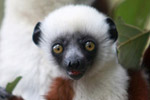
(02/20/2014) Due to the wonderful idiosyncrasies of evolution, there is one country on Earth that houses 20 percent of the world’s primates. More astounding still, every single one of these primates—an entire distinct family in fact—are found no-where else. The country is, of course, Madagascar and the primates in question are, of course, lemurs. But the far-flung island of Madagascar, once a safe haven for wild evolutionary experiments, has become an ecological nightmare. Overpopulation, deep poverty, political instability, slash-and-burn agriculture, illegal logging for lucrative woods, and a booming bushmeat trade has placed 94 percent of the world’s lemurs under threat of extinction, making this the most imperiled mammal group on the planet. But, in order to stem a rapid march toward extinction, conservationists today publicized an emergency three year plan to safeguard 30 important lemur forests in the journal Science.
Microsoft buys Madagascar carbon credits
(02/15/2014) Technology giant Microsoft has bought the first carbon credits generated under a rainforest conservation project in Madagascar, reports Wildlife Conservation Society (WCS), which organized and backed the initiative.
Madagascar’s new president pledges to fight illegal logging
(02/07/2014) Madagascar’s newly elected president Hery Rajaonarimampianina pledged to ‘lead the fight’ against illegal rosewood logging in the impoverished island nation.
Madagascar’s most famous lemur facing big threats
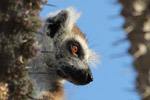
(12/18/2013) The ring-tailed lemur (Lemur catta), perhaps the most well-known of Madagascar’s endemic animals, is facing a “very high” risk of extinction in the wild. The Madagascar Section of the IUCN Primate Specialist Group reassessed the Red List status of ring-tailed lemurs and upgraded the species from Near-Threatened (2008) to Endangered (2012). Ring-tailed lemurs are facing extinction in some parts of Madagascar because of continued habitat loss, and more recently, species exploitation.
Like ancient humans, some lemurs slumber in caves

(12/05/2013) After playing, feeding, and socializing in trees all day, some ring-tailed lemurs (Lemur catta) take their nightly respite in caves, according to a new study in Madagascar Conservation and Development. The findings are important because this is the first time scientists have ever recorded primates regularly using caves (see video below).
Timber smuggling continues in Madagascar
(11/18/2013) Stocks of rosewood illegally harvested during in the aftermath of Madagascar’s 2009 coup are being steadily smuggled off the Indian Ocean island, reports a paper published in the journal MADAGASCAR CONSERVATION & DEVELOPMENT.